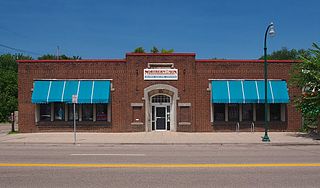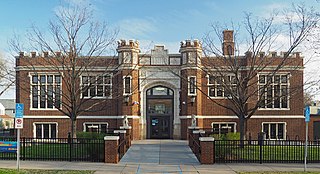
The Minneapolis Public Library (MPL) was a library system that served the residents of Minneapolis, Minnesota in the United States. It was founded in 1885 with the establishment of the Minneapolis Library Board by an amendment to the Minneapolis City Charter. Lumber baron and philanthropist T. B. Walker and other city leaders such as Thomas Lowry were members of the first library board. In 2008, after some financial difficulties, the library was merged into the Hennepin County Library system. At the time of its merger, the library included Central Library in downtown Minneapolis and fourteen branch libraries. Its collection numbered about 3.1 million items with about 2.2 million of these housed in the central library.

Robert Lilligren is an American politician and member of the Minnesota Democratic-Farmer-Labor Party. He was an elected member of the Minneapolis City Council. He was first elected in 2001, to represent the 8th Ward of the Minneapolis City Council. Following the defeat of Green Party member Dean Zimmermann, during the 2005 municipal elections, Lilligren represented the 6th Ward of the City of Minneapolis. When first elected to office, Lilligren was serving as a volunteer on eight different community boards and commissions including: vice-chair of Phillips West Neighborhood organization, the Midtown Greenway Coalition, the Hennepin County-appointed I-35W Project Advisory Committee, and as a board member for several affordable housing groups throughout South Minneapolis. He lost his re-election bid in 2013 to Abdi Warsame. He was appointed to the Metropolitan Council by Governor Tim Walz in March 2019.

Hennepin County Library is a public library system serving Hennepin County, Minnesota, US. The current iteration of Hennepin County Library was formed by the merger of urban Minneapolis Public Library and suburban Hennepin County Library on January 1, 2008. The system has 41 library locations, deposit collections at nursing homes and correctional facilities, mail service to the homebound, and extensive outreach services. With more than 4 million items in its collection, the Hennepin County Library system is one of the largest public libraries in the United States. The library is a department of Hennepin County Government. The library headquarters are in the Ridgedale Library in suburban Minnetonka. The library system has an eleven-member advisory Library Board appointed by the Hennepin County Board of Commissioners. It is a member of the Metropolitan Library Service Agency, a consortium of eight Twin Cities library systems.

Nokomis Library, formerly Nokomis Community Library, is a branch library serving the Nokomis East area of Minneapolis, Minnesota. One of 41 libraries in the Hennepin County Library system, Nokomis was designed by Buetow and Associates, Inc and opened in 1968 as a replacement for the nearby Longfellow Community Library. After being deemed crowded and outdated in 1999, the library underwent a renovation beginning in 2009 that saw it gain a number of environmentally friendly features and an expansion of 4,300 square feet (399 m2). The building reopened in 2011 and includes a restored Wind and Water Chime, a stabile that was part of the original library and that was refurbished and reinstalled by July 2013. The library contains over 35 computers, a public meeting room, and a Spanish-language collection of materials.

Roosevelt Library is one of 41 community libraries in the Hennepin County Library System, originally part of the Minneapolis Public Library System as it is located in Minneapolis, Minnesota, United States.

Sumner Library is a neighborhood library located in the Near-north neighborhood of Minneapolis, Minnesota, United States. Originally part of the Minneapolis Public Library, it became part of the merged Hennepin County Library in 2008. The Carnegie Library was a haven for Jewish immigrants to the city in the early 20th century. The Minneapolis Public Library moved its entire collection of Yiddish and Hebrew works to the branch library in response to a survey showing that 95% of the patrons were Jewish immigrants, some of whom learned English there and participated in social clubs in the building. The Tudor Revival building is listed on the National Register of Historic Places.

East Lake Library is one of 41 branch libraries in the Hennepin County Library System, one of 15 branch libraries formerly in the Minneapolis Public Library System in Minneapolis, Minnesota, United States. Three different buildings have housed the library since 1924.

The Minneapolis Public Library, North Branch building is a former library in Minneapolis, Minnesota, United States. It was designed in 1893 by architect Frederick Corser. When it was opened, it was claimed to be the nation's first branch library to have open shelves so patrons could browse for books on their own, without asking librarians to retrieve them. The library set a precedent for future library development in the Minneapolis Public Library system.

Hosmer Library, originally known as the Thirty-Sixth Street Branch Library, is a branch library of the Hennepin County Library system serving the Central neighborhood of Minneapolis, Minnesota, United States. It was named the Hosmer Library in honor of James Kendall Hosmer and was listed on the National Register of Historic Places in 2000.

The Minneapolis Central Library is a public library located in downtown Minneapolis, Minnesota. It is the largest library in the Hennepin County Library system. It bills itself as having "the third largest per capita public library collection of any major city in America with a collection of more than 2.4 million items—including books, DVDs, music, government documents." The 353,000-square-foot (32,800 m2) building at 300 Nicollet Mall with two levels of underground parking was designed by César Pelli and opened on May 20, 2006. It has over 300 computers for use by the public, an 8,140-square-foot (756 m2) atrium, an 18,560-square-foot (1,724 m2) green roof planted with low-growing ground cover designed to "be sun- and drought-resistant", and a host of energy-efficiency measures.

Arvonne Fraser Library is a public library in Minneapolis, serving the University community. Designed by Ralph Rapson and built in 1963, the library is an example of brutalist architecture. The building originally housed a credit union for state and university employees before a 1967 repurposing, when it became the Southeast Library. Following a subsequent renovation from 2018 to 2020, the library was renamed after Arvonne Fraser, a women's rights advocate and political campaigner.

Pierre Bottineau Library is a branch library located in northeast Minneapolis, Minnesota, United States. It was named for Pierre Bottineau, a prominent Minnesota frontiersman and is one of 41 libraries in the Hennepin County Library System. The library moved to its current location at the historic Grain Belt campus in 2003. The 12,355-square-foot (1,147.8 m2) facility combines two historic buildings, the 1893 Wagon Shed and the 1913 Millwright Shop, with an addition designed by RSP Architects.

Northeast Library is a public library in Minneapolis, Minnesota, United States. It is part of the Hennepin County Library system. Since opening in 1973, Northeast Library at 2200 Central Avenue Northeast in Minneapolis serves a vibrant metropolitan community, Northeast, Minneapolis. At 15,275 square feet, the space held about 30,000 books and featured a fireplace to welcome patrons in winter. The 1973 building was itself a replacement for a Carnegie library which was on the site from 1915 until 1972.
North Regional Library is a public library in Minneapolis, Minnesota, United States. It is part of the Hennepin County Library system. Since opening in 1971, North Regional Library at 1315 Lowry Ave. N. in Minneapolis serves a diverse metropolitan community, Near North, Minneapolis.

Washburn Library, formerly Washburn Community Library, is a public library in the Hennepin County Library system. Opened in September 1970, Washburn Library, located at 5244 Lyndale Avenue South in Minneapolis, began with a footprint of 14,451 square feet (1,342.5 m2) and approximately 18,000 books. Designed by Brooks Cavin, an architect who studied under Walter Gropius and Eero Saarinen, Washburn reflected mid-century modernism. Set near Minnehaha Creek, Washburn meets the needs of Southwest Minneapolis in a picturesque neighborhood.
Augsburg Park Library is a public library in Richfield, Minnesota. A Richfield branch library of Hennepin County Library has existed in various buildings in since 1951.

Brookdale Library is a branch of Hennepin County Library serving the community of Brooklyn Center, Minnesota, United States. The library opened in its current location, 6125 Shingle Creek Parkway, in 1981. As the first structure in Hennepin County to be built in compliance with Minnesota's Sustainable Design Guide, it is one of three Hennepin County structures with a library, county courthouse, licensing and records services office, and social service and community corrections offices. Initially, the library's space was 31,400 square feet (2,920 m2), including three meeting rooms. As the building abuts a swamp and nearby Shingle Creek, native plants were included in the landscaping, using trees, shrubs and plants that thrive in Minnesota's weather and support native animals and insects. A library in Brooklyn Center was part of Hennepin County's long-range library construction program which was published by the 1969 Minnesota State Legislature, authorizing three libraries: Southdale-Hennepin Area Library ; Ridgedale Hennepin Area Library ; and Brookdale Library.

Brooklyn Park Library is a branch of Hennepin County Library serving Brooklyn Park, Minnesota, United States. The current facility opened in June 2016, replacing an earlier library building at 8600 Zane Avenue North that opened in 1976. Prior to that the area was served by Hennepin County Library's bookmobile.
Liebenberg and Kaplan (L&K) was a Minneapolis architectural firm founded in 1923 by Jacob J. Liebenberg and Seeman I. Kaplan. Over a fifty-year period, L&K became one of the Twin Cities' most successful architectural firms, best known for designing/redesigning movie theaters. The firm also designed hospitals, places of worship, commercial and institutional buildings, country clubs, prestigious homes, radio and television stations, hotels, and apartment buildings. After designing Temple Israel and the Granada Theater in Minneapolis, the firm began specializing in acoustics and theater design and went on to plan the construction and/or renovation of more than 200 movie houses throughout Minnesota, North and South Dakota, Iowa, and Wisconsin. Architectural records, original drawings, and plans for some 2,500 Liebenberg and Kaplan projects are available for public use at the Northwest Architectural Archives.





















